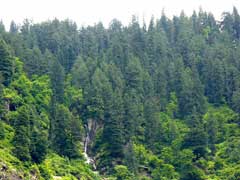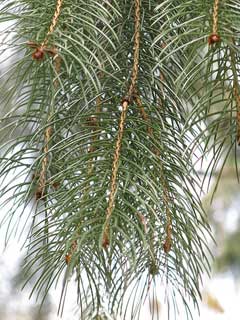 |
|
http://www.flickr.com/people/75823101@N00 |
 |
| http://commons.wikimedia.org/wiki/User:KENPEI |
Translate this page:
Summary
Physical Characteristics

 Picea smithiana is an evergreen Tree growing to 30 m (98ft) by 6 m (19ft) at a slow rate.
Picea smithiana is an evergreen Tree growing to 30 m (98ft) by 6 m (19ft) at a slow rate.
See above for USDA hardiness. It is hardy to UK zone 7 and is not frost tender. It is in leaf all year, and the seeds ripen from October to November. The species is monoecious (individual flowers are either male or female, but both sexes can be found on the same plant) and is pollinated by Wind.
Suitable for: light (sandy), medium (loamy) and heavy (clay) soils and can grow in nutritionally poor soil. Suitable pH: mildly acid, neutral and basic (mildly alkaline) soils and can grow in very acid soils.
It cannot grow in the shade. It prefers moist soil. The plant can tolerates strong winds but not maritime exposure.
It cannot tolerate atmospheric pollution.
UK Hardiness Map
US Hardiness Map
Synonyms
P. morinda.
Plant Habitats
Woodland Garden Canopy;
Edible Uses
Edible Parts: Flowers Inner bark Seed Seedpod Shoots
Edible Uses: Condiment Gum Tea
Young male catkins - raw or cooked. Used as a flavouring[172]. Immature female cones - cooked. The central portion, when roasted, is sweet and syrupy[172]. Inner bark - dried, ground into a powder and then used as a thickener in soups etc or added to cereals when making bread[172]. An emergency food, it is only used when all else fails. Seed - raw. Too small and fiddly to be worthwhile unless you are desperate[172]. A refreshing tea, rich in vitamin C, can be made from the young shoot tips[172].
References More on Edible Uses
Medicinal Uses
Plants For A Future can not take any responsibility for any adverse effects from the use of plants. Always seek advice from a professional before using a plant medicinally.
Vitamin C
None known
References More on Medicinal Uses
The Bookshop: Edible Plant Books
Our Latest books on Perennial Plants For Food Forests and Permaculture Gardens in paperback or digital formats.

Edible Tropical Plants
Food Forest Plants for Hotter Conditions: 250+ Plants For Tropical Food Forests & Permaculture Gardens.
More

Edible Temperate Plants
Plants for Your Food Forest: 500 Plants for Temperate Food Forests & Permaculture Gardens.
More

More Books
PFAF have eight books available in paperback and digital formats. Browse the shop for more information.
Shop Now
Other Uses
Charcoal Gum Resin Roofing Wood
The bark is very water resistant and is used for roofing and making water troughs[146, 158]. Small quantities of resin are obtained from between the bark and the wood[146]. Wood - soft to moderately hard. Used in construction, shingles, crates, household purposes etc[146, 272]. It is also valued for its use in the pulp industry to make paper[171]. An indifferent fuel but it yields a fairly good charcoal[158].
Special Uses
References More on Other Uses
Cultivation details
Likes abundant moisture at the roots, if grown in drier areas it must be given a deep moist soil[11]. Tolerates poor peaty soils[200]. Succeeds in wet cold and shallow soils but is not very wind-firm in shallow soils[1]. Succeeds in most sites, including limestone[81]. Prefers a pH between 4 to 6[200]. Dislikes shade[200]. Intolerant of atmospheric pollution[11]. Resists wind exposure to some degree[200]. Most trees are only hardy to zone 8 (tolerating temperatures down to about -5 to -10°c) but selected clones can succeed in zone 7 with temperatures down to -15°c[200]. In some upland areas, especially over granitic or other base-poor soils, growth rate and health have been seriously affected by aluminium poisoning induced by acid rain[200]. Plants are strongly outbreeding, self-fertilized seed usually grows poorly[200]. They hybridize freely with other members of this genus[200]. Difficult to establish because it is sensitive to frost until it is 1.5 metres or more tall, young plants should be given a position sheltered from the early morning sun[11]. Established trees can grow quite vigorously making new growth of 60cm per year for a number of years[185]. Plants in general are slow-growing[1888]. Trees should be planted into their permanent positions when they are quite small, between 30 and 90cm. Larger trees will check badly and hardly put on any growth for several years. This also badly affects root development and wind resistance[200].
References Carbon Farming Information and Carbon Sequestration Information
Temperature Converter
Type a value in the Celsius field to convert the value to Fahrenheit:
Fahrenheit:
The PFAF Bookshop
Plants For A Future have a number of books available in paperback and digital form. Book titles include Edible Plants, Edible Perennials, Edible Trees,Edible Shrubs, Woodland Gardening, and Temperate Food Forest Plants. Our new book is Food Forest Plants For Hotter Conditions (Tropical and Sub-Tropical).
Shop Now
Plant Propagation
Seed - stratification will probably improve germination so sow fresh seed in the autumn in a cold frame if possible[80]. Sow stored seed as early in the year as possible in a cold frame[78]. A position in light shade is probably best[78]. Seed should not be allowed to dry out and should be stored in a cool place[80]. Prick out the seedlings into individual pots when they are large enough to handle and grow them on in the greenhouse or cold frame for their first winter. They can be planted out into their permanent positions in early summer of the following year, or be placed in an outdoor nursery bed for a year or so to increase in size. They might need protection from spring frosts. Cuttings of semi-ripe terminal shoots, 5 - 8cm long, August in a frame. Protect from frost. Forms roots in the spring[78]. Cuttings of mature terminal shoots, 5 - 10cm long, September/October in a cold frame. Takes 12 months[78]. Cuttings of soft to semi-ripe wood, early summer in a frame. Slow but sure.
Other Names
If available other names are mentioned here
Native Range
TEMPERATE ASIA: Afghanistan TROPICAL ASIA: India (Jammu and Kashmir), Nepal
Weed Potential
Right plant wrong place. We are currently updating this section.
Please note that a plant may be invasive in one area but may not in your area so it's worth checking.
Conservation Status
IUCN Red List of Threatened Plants Status :

Growth: S = slow M = medium F = fast. Soil: L = light (sandy) M = medium H = heavy (clay). pH: A = acid N = neutral B = basic (alkaline). Shade: F = full shade S = semi-shade N = no shade. Moisture: D = dry M = Moist We = wet Wa = water.
Now available:
Food Forest Plants for Mediterranean Conditions
350+ Perennial Plants For Mediterranean and Drier Food Forests and Permaculture Gardens.
[Paperback and eBook]
This is the third in Plants For A Future's series of plant guides for food forests tailored to
specific climate zones. Following volumes on temperate and tropical ecosystems, this book focuses
on species suited to Mediterranean conditions—regions with hot, dry summers and cool, wet winters,
often facing the added challenge of climate change.
Read More
Expert comment
Author
(Wall.)Boiss.
Botanical References
11200
Links / References
For a list of references used on this page please go here
Readers comment
© 2010, Plants For A Future. Plants For A Future is a charitable company limited by guarantee, registered in England and Wales. Charity No. 1057719, Company No. 3204567.